#Automotive industries
Text
Fuel Cell Generator Market Is Driven by Minimalization of Carbon Residues
The size of the fuel cell generator market was USD 330 million in 2022, and the figure is set to rise at a CAGR of 17.50% from 2022 to 2030 and reach USD 1,199 million by the end of this decade.
There are several reasons for this development, including the minimalization of CO2 emissions, the easy availability of fuel cells, and their ability to renew energy. The snowballing need for the production of clean power along with minimal releases from CO2 will drive the market.

Numerous regions and nations throughout the globe are targeting to decrease overall releases of CO2 to zero by 2050, To achieve CO2 neutrality. The government's focus has amplified on making a decarbonized civilization in the past few years. To achieve this aim, the introduction of renewable sources, including solar, biomass, hydro, wind, and geothermal, is vital.
The production of electricity with the support of solar and wind has a few drawbacks, like the lack of ability to regulate the generation and huge quantity of output disparities reliant on weather conditions.
Aquaculture is the fastest-rising end-user developing at a CAGR of approximately 19.2%, credited to the increasing quantity of aquaculture amenities and increasing ecological impacts related to it such as the consumption of electricity and water. Mainly to lessen the environmental effects, governments have taken numerous steps to utilize fuel cell-based generators as an alternative to diesel generators.
North America is dominating the fuel cell generator market and is projected to continue with this dominance throughout the decade. This can be ascribed to the growing concentration and fast acceptance of clean sources.
In North America, the U.S. is leading the market, and it will develop with a CAGR of 18.1%, credited to solid economic support. The innovative growth in the usage of renewable sources and snowballing electricity needs from the aquaculture and data centers industry are the major reasons that will boost the industry in the future as well.
Hence, the minimalization of CO2 emissions, the easy availability of fuel cells, and their ability to renew energy are the major factors contributing to the growth of the fuel cell generator market.
#Fuel Cell Generator Market#Market Trends#Fuel Cell Technologies#Clean Power Generation#Backup Power Systems#Mobile Applications#Market Dynamics#Key Players#Emerging Opportunities#Energy Solutions#Telecommunications#Automotive Industries#Sustainability#Resilience#Decentralized Power Generation
0 notes
Text
What The Role of Desiccants in the Automotive Industry Experts Want You to Know
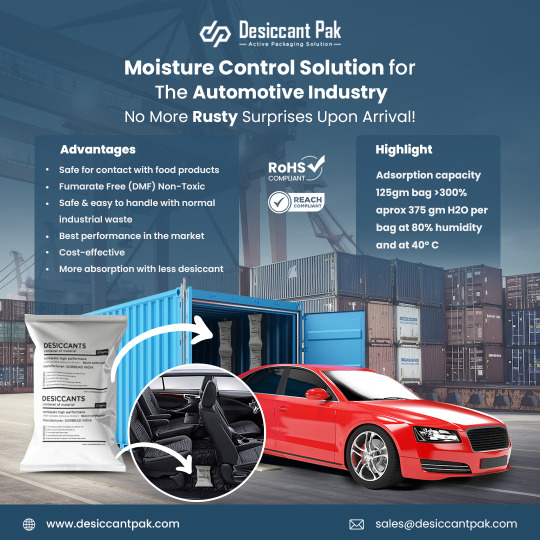
The part of Desiccants in the Automotive Assiduity preface In the fast- paced and dynamic world of the automotive assiduity, perfection and trustability are consummate. Manufacturers and suppliers strive to insure that every element performs at its stylish, and this includes keeping humidity and moisture at bay. In this regard, desiccants play a pivotal part in maintaining the integrity of automotive products. In this comprehensive composition, we will claw into the significance of desiccants in the automotive assiduity and their colorful operations, showcasing their significance in enhancing product quality and life.
1. What is Desiccants ?
Desiccants are hygroscopic substances able of absorbing and retaining humidity from the girding terrain. They work by creating a dry terrain within a sealed space, effectively precluding the build up of condensation and moistness. In the automotive assiduity, desiccants are primarily used to cover sensitive factors and accoutrements from humidity damage during manufacturing, shipping, and storehouse.
2. Why Desiccants used in Automotive industries?
During the manufacturing process of automotive factors, exposure to humidity can lead to erosion, declination, and indeed complete failure of corridor. To help similar issues, desiccants are integrated into the product line. From the manufacturing of electronic control units( ECUs) to airbag modules and optic detectors, desiccants are strategically placed to insure optimal performance and tractability.
3. Desiccants used in Automotive Storage & Shipping
The trip of automotive corridor from the manufacturer to the assembly line involves colorful stages of transportation and warehousing. These stages can subdue the factors to varying temperature and moisture conditions. Desiccants are incorporated into packaging accoutrements to guard the products from humidity- related damages during conveyance and storehouse. By barring humidity, desiccants help maintain the original quality of the factors until they're ready for installation.
4 Several types of Desiccants for in the Automotive Industry
Several types of desiccants find operations in the automotive sector. Each type possesses distinct characteristics suited for specific conditions. Some generally used desiccants include
Silica Gel Silica gel is one of the most extensively used desiccants in the automotive assiduity. Its high face area and excellent humidityabsorbing capacity make it an ideal choice for guarding sensitive electronic factors.
Molecular Sieve Molecular sieve desiccants are preferred for operations where exceptionally low moisture situations are needed. They're generally used in air exertion systems and energy tanks to maintain dry conditions.
Clay Desiccants Clay desiccants are provident and effective for humidity immersion. They're generally used for guarding larger automotive factors during shipping and storehouse.
Calcium Chloride Desiccants These desiccants have a high humidity immersion rate and are ideal for diving extreme moisture conditions during conveyance.
5. Impact on Automotive Performance
The use of desiccants in the automotive assiduity has a direct impact on product performance and overall quality. Then is how desiccants contribute to enhancing automotive performance Enhanced Electrical Performance humidity can compromise the electrical integrity of colorful automotive factors, leading to malfunctions or failure. Desiccants insure that sensitive electronics, similar as ECUs, detectors, and infotainment systems, remain dry and function optimally. Increased Life By guarding automotive corridor from humidity- related damage, desiccants contribute to the extended lifetime of factors. This leads to advanced client satisfaction and reduces the need for frequent reserves. Improved Safety In critical safety factors like airbag modules, any humidity intrusion could lead to malfunction during deployment. Desiccants guarantee that these safety features remain in perfect condition, furnishing dependable protection to passengers.
6. Environmental Impact piecemeal from their performance benefits,
Desiccants also play a part in reducing the environmental impact of the automotive assiduity. By conserving the quality of factors, desiccants help help unseasonable failures, reducing the overall waste generated. also, desiccants themselves can frequently be disposed of in aneco-friendly manner. 7. unborn Trends As the automotive assiduity continues to evolve, so will the use of desiccants. inventions in desiccant technology will lead to more effective and sustainable results for humidity control. Manufacturers will concentrate on integrating smarter humidity operation systems to meet the adding demands of the assiduity.
Conclusion
Desiccants are obscure icons in the automotive assiduity, quietly icing that critical factors perform at their stylish. From guarding electronic systems to conserving safety features, their impact on product quality and life can not be exaggerated. As the automotive assiduity embraces advancements in humidity control, desiccants will remain necessary for achieving peak performance and client satisfaction.
#humiditycontrol#moistureabsorbers#shipping#desiccantsilicagel#packagingsolutions#automotive#cargo transport#cargo shipping#self care#desiccant#Automotive industries#electronic systems#Clay Desiccants#automotive products
0 notes
Text
Automotive Component Manufacturers in Bangalore
Vieng is one of the leading small scale units exporting precision machined components and assemblies. The company is certified for ISO 9001: 2015.
Our high precision parts are used in the field of Tools, Automotive, Electrical, Railways, Aerospace, Defence and Medical industries.
Retention of customers is the prime focus of our organization. This is being achieved by sustained quality, consistent delivery at a competitive price.

0 notes
Text

if you can’t identify what i’m thinking about at any given moment there’s a nonzero chance it’s train systems
373 notes
·
View notes
Text

#car photo#classic car#classic cars#cars#car#vintage cars#vintage style#vintage#auto news#automobile#automotive#auto#car photography#car porn#car photoshoot#old car#old cars#street photography#car industry
180 notes
·
View notes
Text

Vertical parking garage in Chicago. [1936]
#architecture#automotive#film photography#analog#urban#chicago#industrial#black and white#monochrome#30s#photography#u
88 notes
·
View notes
Text
Umbrellas and automobiles are different. Not just because of size, function, and cost. But for a reason we seldom stop to consider. A person can use an umbrella without buying another product. An automobile, by contrast, is useless without fuel, oil, repair services, spare parts, not to mention streets and roads. The humble umbrella, therefore, is a rugged individual, so to speak, delivering value to its user irrespective of any other product.
The mighty auto, by contrast, is a team player completely dependent on other products. So is a razor blade, a tape recorder, a refrigerator, and thousands of other products that work only when combined with others. The television set would stare blankly into the living room if someone somewhere were not transmitting images to it. Even the lowly closet hanger presupposes a rack or bar to hang it on.
Each of these is part of a product system. It is precisely their systemic nature that is their main source of economic value. And just as "team players" must play by certain agreed-on rules, systemic products need standards to work. A three-pronged electrical plug doesn't help much if all the wall sockets have only two slots.
This distinction between stand-alone and systemic products throws revealing light on an issue that is widening today's information wars all around the world. The French call it la guerre des normes—“the war over standards." Battles over standards are raging in industries as diverse as medical technology, industrial pressure vessels, and cameras.
Alvin Toffler, Powershift: Knowledge, Wealth, and Power at the Edge of the 21st Century
#quote#Alvin Toffler#Toffler#power#powershift#technology#standards#automotive#umbrellas#systems#products#product design#industry#cars
239 notes
·
View notes
Text

industrial robots
#KUKA#robot#industrial robot#manufacturing#heavy industry#automotive#FIAT#Italy#Torino#Turin#FIAT 500
209 notes
·
View notes
Photo





audi activesphere concept
349 notes
·
View notes
Text
Ko-fi prompt from @thisarenotarealblog:
There's a street near me that has eight car dealerships all on the same lot- i counted. it mystifies me that even one gets enough sales to keep going- but 8?? is there something you can tell me that demystifies this aspect of capitalism for me?
I had a few theories going in, but had to do some research. Here is my primary hypothesis, and then I'll run through what they mean and whether research agrees with me:
Sales make up only part of a dealership's income, so whether or not the dealership sells much is secondary to other factors.
Dealerships are put near each other for similar reasons to grouping clothing stores in a mall or restaurants on a single street.
Zoning laws impact where a car dealership can exist.
Let's start with how revenue works for a car dealership, as you mentioned 'that even one gets enough sales to keep going' is confusing. For this, I'm going to be using the Sharpsheets finance example, this NYU spreadsheet, and this Motor1 article.
This example notes that the profit margin (i.e. the percentage of revenue that comes out after paying all salaries, rent, supply, etc) for a car dealership is comparatively low, which is confirmed by the NYC sheet. The gross profit margin (that is to say, profits on the car sale before salaries, rent, taxes) is under 15% in both sources, which is significantly lower than, say, the 50% or so that one sees in apparel or cable tv.
Cars are expensive to purchase, and can't be sold for much more than you did purchase them. However, a low gross profit margin on an item that costs tens of thousands of dollars is still a hefty chunk of cash. 15% gross profit of a $20,000 car is still $3,000 profit. On top of that, the dealership will charge fees, sell warranties, and offer upgrades. They may also have paid deals to advertise or push certain brands of tire, maintenance fluids, and of course, banks that offer auto loans. So if a dealership sells one car a day, well, that's still several thousand dollars coming in, which is enough to pay the salaries of most of the employees. According to the Motor1 article, "the average gross profit per new vehicle sits at $6,244" in early 2022.
There is also a much less volatile, if also much smaller, source of revenue in attaching a repairs and checkup service to a dealership. If the location offers repairs (either under warranty or at a 'discounted' rate compared to a local, non-dealership mechanic), state inspections, and software updates, that's a recurring source of revenue from customers that aren't interested in purchasing a car more than once a decade.
This also all varies based on whether it's a brand location, used vs new, luxury vs standards, and so on.
I was mistaken as to how large a part of the revenue is the repairs and services section, but the income for a single dealership, on average, does work out math-wise. Hypothesis disproven, but we've learned something, and confirmed that income across the field does seem to be holding steady.
I'm going to handle the zoning and consolidation together, since they overlap:
Consolidation is a pretty easy one: this is a tactic called clustering. The expectation is that if you're going to, say, a Honda dealership to look at a midsize sedan, and there's a Nissan right next door, and a Ford across the street, and a Honda right around the corner, you might as well hit up the others to see if they have better deals. This tactic works for some businesses but not others. In the case of auto dealerships, the marketing advantage of clustering mixes with the restrictions of zoning laws.
Zoning laws vary by state, county, and township. Auto dealerships can generally only be opened on commercially zoned property.
I am going to use an area I have been to as an example/case study.
This pdf is a set of zoning regulations for Suffolk County, New York, published 2018, reviewing land use in the county during 2016. I'm going to paste in the map of the Town of Huntington, page 62, a region I worked in sporadically a few years ago, and know mostly for its mall and cutesy town center.
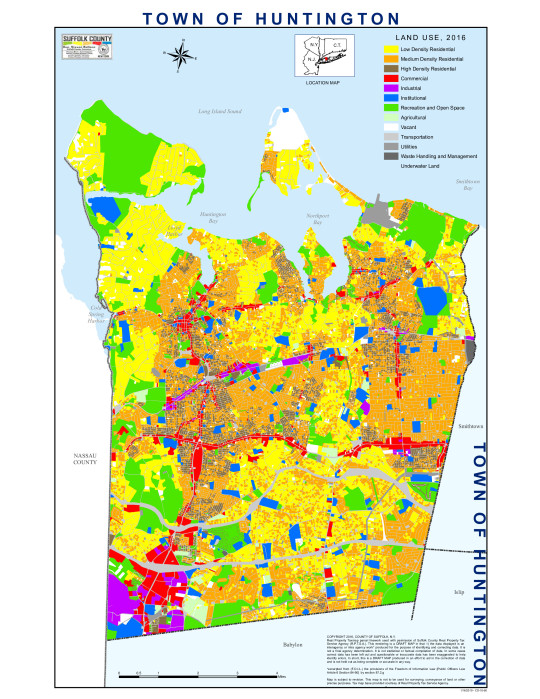
Those red sections are Commercially Zoned areas, and they largely follow some large stroads, most notably Jericho Turnpike (the horizontal line halfway down) and Walt Whitman Road (the vertical line on the left). The bulge where they intersect is Walt Whitman Mall, and the big red chunk in the bottom left is... mostly parking. That central strip, Jericho Turnpike, and its intersection with Walt Whitman... looks like this:

All those red spots are auto dealerships, one after another.
So zoning laws indicate that a dealership (and many other types of commercial properties) can only exist in that little red strip on the land use map, and dealerships take up a lot of space. Not only do they need places to put all of the cars they are selling, but they also need places to park all their customers and employees.
This is where we get into the issue of parking minimums. There is a recent video from Climate Town, with a guest spot by NotJustBikes. If you want to know more about this aspect of zoning law, I'd recommend watching this video and the one linked in the description.
Suffolk county does not have parking minimums. Those are decided on a town or village level. In this case, this means we are looking at the code set for the town of Huntington. (I was originally looking on the county level, and then cut the knot by just asking my real estate agent mom if she knew where I could find minimum parking regulations. She said to look up e360 by town, and lo and behold! There they are.)
(There is also this arcgis map, which shows that they are all within the C6 subset of commercial districting, the General Business District.)
Furniture or appliance store, machinery or new auto sales
- 1 per 500 square feet of gross floor area
Used auto sales, boat sales, commercial nurseries selling at retail
- 5 spaces for each use (to be specifically designated for customer parking)
- Plus 1 for each 5,000 square feet of lot area
This is a bit odd, at first glance, as the requirements are actually much lower than that of other businesses, like drive-in restaurants (1 per 35 sqft) or department stores (1 per 200 sqft). I could not find confirmation on whether the 'gross floor area' of the dealership included only indoor spaces or also the parking lot space allotted to the objects for sale, but I think we can assume that any parking spaces used by merchandise do not qualify as part of the minimum. Some dealerships can have up to 20,000 gross sqft, so those would require 40 parking spaces reserved solely for customers and employees. Smaller dealerships would naturally need less. One dealership in this area is currently offering 65 cars of varying makes and models; some may be held inside the building, but most will be on the lot, and the number may go higher in other seasons. If we assume they need 30 parking spaces for customers and employees, and can have up to 70 cars in the lot itself, they are likely to have 100 parking spaces total.
That's a lot of parking.

Other businesses that require that kind of parking requirement are generally seeing much higher visitation. Consider this wider section of the map:

The other buildings with comparative parking are a grocery store (Lidl) and a post office (can get some pretty high visitation in the holiday season, but also just at random).
Compare them, then, to the "old town" section of the same town.
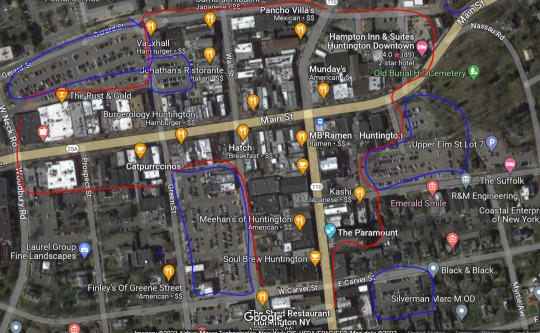
There are a handful of public parking areas nearby (lined in blue), whereas the bulk of the businesses are put together along this set of streets. While there is a lot of foot traffic and vehicle passage, which is appealing for almost any business, opening a car dealership in this area would require not only buying a building, but also the buildings surrounding it. You would need to bulldoze them for the necessary parking, which would be prohibitively expensive due to the cost of local real estate... and would probably get shot down in the application process by city planners and town councils and so on. Much easier to just buy land over in the strip where everyone's got giant parking lots and you can just add a few extra cramped lanes for the merchandise.
Car dealerships also tend to be very brightly lit, which hits a lot of NIMBY sore spots. It's much easier to go to sleep if you aren't right next to a glaring floodlight at a car dealership, so it's best if we just shove them all away from expensive residential, which means towards the loud stroads, which means... all along these two major roads/highways.
And if they're all limited to a narrow type of zoning already, they might as well take advantage of cluster marketing and just all set up shop near each other in hopes of stealing one of the other's customers.
As consumers, it's also better for us, because if we want to try out a few different cars from a few different brands, it's pretty easy to just go one building down to try out the Hyundai and see if it's better than a Chevy in the same price group.
(Prompt me on ko-fi!)
#economics prompts#marketing#zoning laws#ko fi prompts#ko fi#auto industry#automotive dealerships#car dealerships#phoenix posts
110 notes
·
View notes
Text


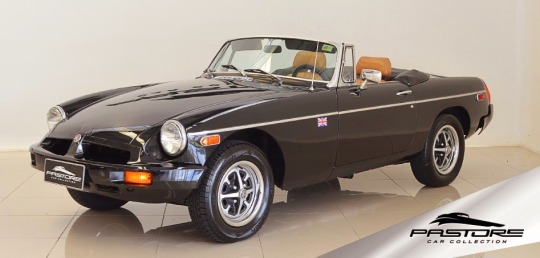




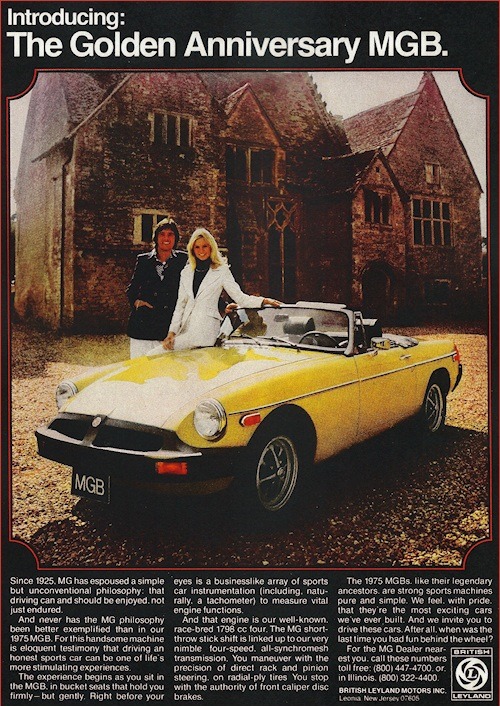
🇬🇧 Embark on a journey through time with the iconic MG MGB —a classic car that has captured the hearts of enthusiasts around the world! Since its introduction in the 1960s, the MGB Roadster has been synonymous with British motoring heritage, combining timeless design with exhilarating performance.
👉 The story of the MG MGB begins in 1962 when it made its debut as the successor to the popular MGA. Designed to appeal to a new generation of drivers, the MGB featured sleek lines, a convertible top, and a powerful engine, making it an instant hit among sports car enthusiasts.
🚘 Under the hood, the MGB was powered by a range of inline-four engines, delivering lively performance and agile handling. Its lightweight construction and responsive steering made it a joy to drive, whether cruising along winding country roads or tackling hairpin turns on the racetrack.
💡 The MGB quickly gained a reputation for its reliability and affordability, earning it a dedicated fanbase that continues to grow to this day. With its timeless design and spirited performance, the MGB remains a sought-after classic car among collectors and enthusiasts worldwide.
⚙️ Over the years, the MGB underwent various updates and revisions, reflecting advancements in automotive technology and design. Despite changes in the automotive landscape, its enduring appeal and iconic status have cemented its place in automotive history.
🌟 Whether admired for its elegant lines, spirited performance, or rich heritage, the MG MGB Roadster continues to captivate drivers and enthusiasts with its timeless charm and undeniable charisma.
#brits and yanks on wheels#retro cars#transatlantic torque#vehicle#cars#old cars#brands#companies#automobile#american cars#mg#mg motor#mg rover group#british automotive#british motor corporation#british cars#british leyland#english cars#old car#classic car#cool cars#race car#sport cars#sports cars#vintage cars#history#morris garage#classic cars#automotive#industry
22 notes
·
View notes
Text
With electric vehicle sales in Canada breaking records every year, the demand is clear, say advocates of EVs.
"There is currently very high interest, and that interest is growing," said Louise Lévesque, director of policy at Electric Mobility Canada, a national industry association that works to advance electric transportation.
Environment Minister Steven Guilbeault last week unveiled the federal government's electric vehicle sales mandate regulations, which include a national target of 100 per cent zero-emission vehicle sales by 2035. In making his announcement, Guilbeault also noted how the Canadian marketplace is already experiencing "a rapid shift toward zero-emission vehicles."
But some observers say the market and demand for EVs is more nuanced, that data shows most Canadians still aren't particularly eager to buy one and that the targets laid out by Guilbeault might be difficult to achieve.
"If we have to get to 100 per cent of new car sales by 2035, the path we're on right now won't get us there," said Niel Hiscox, president of Clarify Group Inc., a Canadian-based automotive research and advisory firm. [...]
Continue Reading.
Tagging: @politicsofcanada
30 notes
·
View notes
Text
Automotive Component Manufacturers in Bangalore
Vieng is one of the leading small scale units exporting precision machined components and assemblies. The company is certified for ISO 9001: 2015.
Our high precision parts are used in the field of Tools, Automotive, Electrical, Railways, Aerospace, Defence and Medical industries.
Retention of customers is the prime focus of our organization. This is being achieved by sustained quality, consistent delivery at a competitive price.
0 notes
Text



the novice, the scholar, and the stray dog
or, the sole remaining members of the brotherhood's (defunct) detroit bureau in ASSASSIN'S CREED: MOTOR CITY
template made by @unholymilf (tumblr wouldn't let me tag directly, so linking to the blog instead)
#oc: athena dawson#oc: hanan al-saif#oc: nathaniel adler#had to take hephaestus' hammer to free this trio from my brain#which. is an apt analogy since the protagonist of this whole story is named athena#thinking this whole thing takes place in like 2018 but i'm not set on where in the timeline it happens#still ironing things out tbh#two survivors of a templar attack (hanan and nate) and one novice (athena)#and not a single master assassin between them :) they're doing fine :)#historical timeline takes place during the automotive industry boom/prohibition#it's canon henry ford was a templar and i NEED him to get his ass handed to him#also these three have big sibling dynamics (shithead big brother. impulsive youngest sister. poor hanan left in middle child mediation mode#anyway. had to exorcise these guys from my brain#verse: assassin's creed: motor city#my edits
14 notes
·
View notes
Text
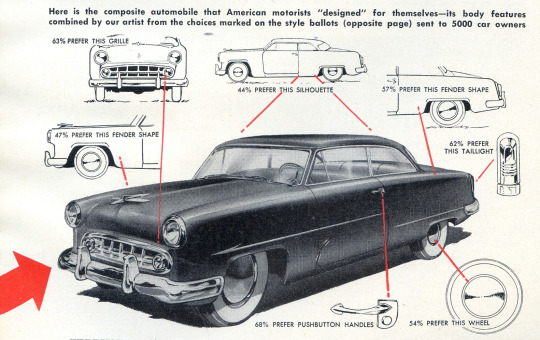
This is why they don't let any Joe Schmoe to design cars.
Popular Mechanics - March 1954
#vintage illustration#illustration#automotive#1954#1950s#1950's#care design#industrial design#funny#humor#humour
12 notes
·
View notes
Text


Modern cars do more than get you from Point A to Point B. With sophisticated, internet-enabled onboard computers, they provide vehicle manufacturers with a truckload (pun intended) of data on where you’re driving, what you’re buying, demographic data and more. So what are they doing with all this information? That’s what the newly created California Privacy Protection Agency would like to know, and so it has launched a review of the auto industry’s data privacy practices.
“Modern vehicles are effectively connected computers on wheels. They’re able to collect a wealth of information via built-in apps, sensors, and cameras, which can monitor people both inside and near the vehicle,” said CPPA Executive Director Ashkan Soltani in a statement.
With more than 35 million vehicles on the road in the Golden State, that is a lot of data for these car-makers to scoop up. [And sell!]
The announcement was hailed by advocacy group Consumer Watchdog’s Justin Kloczko, who said in a statement, “These companies know more about us than we know about ourselves, and they’re the ones in control of our personal information, not us.”
(continue reading)
#connected cars#privacy rights#smart cars#data mining#geolocation tracking#data privacy#automotive industry#insurance#car insurance#spyware
34 notes
·
View notes